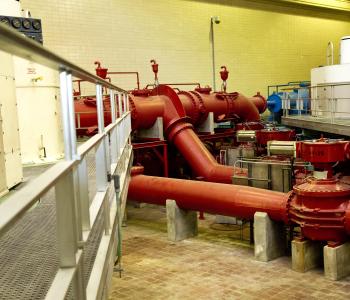DC Water Collaborates with Virginia Tech to Identify Lead Risks in Water
The District of Columbia Water and Sewer Authority (DC Water) is partnering with Virginia Tech College of Engineering to evaluate the federal Lead and Copper Rule, an Environmental Protection Agency regulation designed to protect U.S. consumers from elevated levels of lead and copper in drinking water.
Under the 1991 Lead and Copper Rule, responsibility for avoiding harmful exposures to lead in drinking water is shared between regulated water utilities and unregulated consumers. The research will examine potential weaknesses in three key requirements of the law: Water sampling methods to measure lead levels, replacement of water lines that contain lead, and public education initiatives aimed at promoting safe water-use practices.
This is a very timely research project, that will obtain sound data that can inform EPAs efforts to improve the public health protection, said Marc Edwards of Virginia Tech, who is the Charles Lunsford Professor of Civil Engineering and a 2008 MacArthur Fellow.
Findings from this study may be used to help the EPA craft a stronger Lead and Copper Rule, and help policy makers shape future laws and regulations that address various contaminants that could be found in water, Edwards said.
Awarded by the Robert Wood Johnson Foundations Public Health Law Research program, the study will bring together experts from the fields of engineering, science, law, anthropology and public health to gather data and identify necessary revisions for improved public health protection.
The research team includes Edwards, members from Northeastern Universitys Dukakis Center for Urban and Regional Policy and the Washington, D.C.-based Parents for Nontoxic Alternatives, an advocacy group dedicated to childrens environmental health initiatives.
Representatives of the EPAs Office of Research and Development and the Childrens National Medical Center in Washington, D.C., will review scientific and public health components of the research, respectively.
Additional study partners include representatives from three cities with high incidences of lead plumbing material usage and relatively high rates of childhood lead poisoning: The Childhood Lead Action Project in Providence, R.I.; the Metropolitan Tenants Organization of Chicago; and the Vanguard Community Development Corporation in Detroit.
The District of Columbia Water and Sewer Authority, of Washington, D.C., also will directly collaborate and support the teams research effort. The agencys participation in the work underscores a commitment to proactive leadership on water quality and the protection of public health.
This study is a unique opportunity to advance our understanding of lead in drinking water, in cooperation with research and advocacy partners, said George S. Hawkins, D.C. Waters general manager. We share the responsibility with our consumers in identifying lead in water trends and minimizing potential public health risks.
The rule now gives water utilities leeway to monitor lead in drinking water, using protocols that might miss potential contamination hazards. Moreover, recent research has shown that in at least some cases, the replacement of municipal lead pipes up to a homes property line -- without replacing the private portion of the pipes -- can actually increase lead-in-water problems.
Earlier this year, the Centers for Disease Control and Prevention issued an alert about the potential for increased likelihood of childhood lead poisoning following this expensive procedure. Many industry groups, including representatives of the American Water Works Association, are requesting a moratorium on such work.
The Virginia Tech research team will examine potential conditions in which long-term problems with high lead in water tend to arise.







